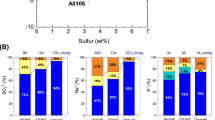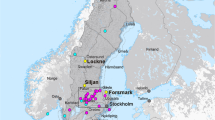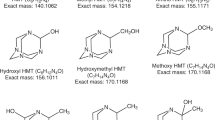Abstract
WITH very few exceptions1 the insoluble organic matter present in both Pre-Cambrian sediments and carbonaceous chondrites has been neglected and organo-geochemical studies of these materials have been largely devoted to the readily solvent extractable soluble organic substances2. This is in some ways unfortunate, for by far the greater proportion of carbonaceous matter in both Pre-Cambrian sediments (up to 95 per cent)3 and in carbonaceous chondrites (up to 70 per cent)4 is insoluble and the soluble matter is frequently of a very minor nature. In addition, the soluble, and so potentially more mobile, organic chemicals are more likely to have moved in total or in part from their point of origin, and problems of rock contamination with such substances, either over long periods through seepage or, in the case of meteorites, at impact5, are especially acute.
This is a preview of subscription content, access via your institution
Access options
Subscribe to this journal
Receive 51 print issues and online access
$199.00 per year
only $3.90 per issue
Buy this article
- Purchase on Springer Link
- Instant access to full article PDF
Prices may be subject to local taxes which are calculated during checkout
Similar content being viewed by others
References
Bitz, M. C., and Nagy, B., Proc. US Nat. Acad. Sci., 56, 1323 (1966).
Calvin, M., in Chemical Evolution (Oxford University Press, 1969).
Schopf, J. S., J. Paleontol, 42, 651 (1968); Meinschein, W. G., Space Science Rev., 2, 480 (1963).
Hayes, J. M., Geochim. Cosmochim. Acta, 31, 1395 (1967).
Han, J., Simoneit, B. R., Burlingame, A. L., and Calvin, M., Nature, 222, 364 (1969).
Brooks, J., and Shaw, G., Nature, 219, 532 (1968); Grana Palynologica, 8, (2–3), 227 (1968).
Brooks, J., and Shaw, G., Nature, 220, 678 (1968).
Shaw, G., Sporopollenin, in Photochemical Phylogeny (Academic Press, New York and London, in the press).
Nagy, B., and Claus, G., in Advances in Organic Geochemistry, 109 (Pergamon Press, London, 1964).
Barghoorn, E. S., and Schopf, J. W., Science, 152, 758 (1956); Pflug, Hans D., Rev. Paleobotan. Palynol., 5, 9 (1967).
Anders, E., Accounts of Chemical Research, 1 (10), 289 (1968); Cameron, A. G. W., Space Sci., 711, (Blackie Ltd, London, 1965).
Sutton, J., Proc. Geol. Assoc., 78 (4), 493 (1967).
Author information
Authors and Affiliations
Rights and permissions
About this article
Cite this article
BROOKS, J., SHAW, G. Evidence for Extraterrestrial Life: Identity of Sporopollenin with the Insoluble Organic Matter present in the Orgueil and Murray Meteorites and also in some Terrestrial Microfossils. Nature 223, 754–756 (1969). https://doi.org/10.1038/223754b0
Received:
Issue Date:
DOI: https://doi.org/10.1038/223754b0
This article is cited by
-
Review of organic matter in the Orgueil meteorite
Space Life Sciences (1971)
-
Extra terrestrial abiogenic organization of organic matter: The hollow spheres of the Orgueil meteorite
Space Life Sciences (1971)
-
Pyrolysis of Early Pre-Cambrian Onverwacht Organic Matter (> 3 × 109 yr old)
Nature (1970)
Comments
By submitting a comment you agree to abide by our Terms and Community Guidelines. If you find something abusive or that does not comply with our terms or guidelines please flag it as inappropriate.



